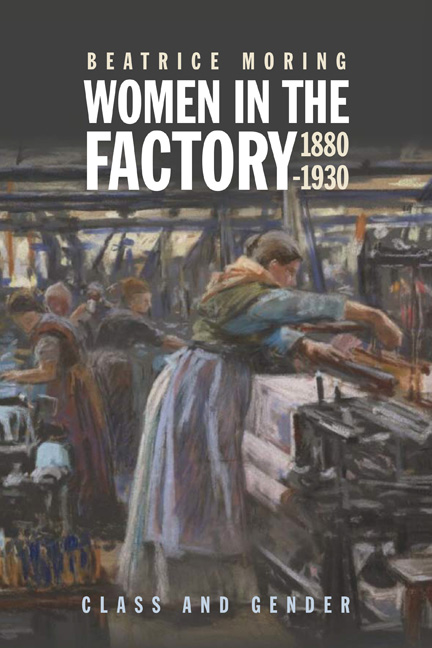Book contents
- Frontmatter
- Contents
- List of Illustrations
- Introduction – Why Women in the Factory?
- 1 Gender And Class – Male Unions, Political Movements and the Female Vote
- 2 Women in Industry: Work, Sectors, Age and Marital Status
- 3 Women, Earnings and the Household – Why the Factory?
- 4 Accidents, Compensation, Laws and Inspection
- 5 Middle Class Girls, Education and Entry into the Civil Service
- 6 The Female Factory Inspectors – How, Why and Who
- 7 Factory Inspection Activity
- 8 Class, Gender and Communication
- Conclusion
- Appendix 1 The Right for Women to Vote in National Elections
- Appendix 2 Women in the Workforce
- Appendix 3 Women, Work, Earnings and Family
- Appendix 4 Accidents, Workplace Acts and Regulations
- Appendix 5 Education
- Appendix 6 Female Inspectors
- Appendix 7 Inspectors, Activity
- Appendix 8 The Female Inspectors and Society
- Bibliography
- Index
4 - Accidents, Compensation, Laws and Inspection
Published online by Cambridge University Press: 09 May 2024
- Frontmatter
- Contents
- List of Illustrations
- Introduction – Why Women in the Factory?
- 1 Gender And Class – Male Unions, Political Movements and the Female Vote
- 2 Women in Industry: Work, Sectors, Age and Marital Status
- 3 Women, Earnings and the Household – Why the Factory?
- 4 Accidents, Compensation, Laws and Inspection
- 5 Middle Class Girls, Education and Entry into the Civil Service
- 6 The Female Factory Inspectors – How, Why and Who
- 7 Factory Inspection Activity
- 8 Class, Gender and Communication
- Conclusion
- Appendix 1 The Right for Women to Vote in National Elections
- Appendix 2 Women in the Workforce
- Appendix 3 Women, Work, Earnings and Family
- Appendix 4 Accidents, Workplace Acts and Regulations
- Appendix 5 Education
- Appendix 6 Female Inspectors
- Appendix 7 Inspectors, Activity
- Appendix 8 The Female Inspectors and Society
- Bibliography
- Index
Summary
The rules of this law are to be applied to every machine that can pose a danger for the life or health of a person using them. This applies to machines powered by steam, gas, water, wind etc. or by animals. It applies both to machines used for the work and those generating power and all connecting wheels, axels, power cords or belts, electrical cords etc. used for connecting the power to work machines.
… Working machines should be constructed and placed and connecting moving parts be fenced or covered so that the workers engaged with them could only in case of extreme carelessness come into connection with moving parts when pursuing their normal duties.
(First and second paragraphs of the Law about Preventing Accidents When Using Machines etc. of 12 April 1889, by royal declaration, Christian IX of Denmark)A factory could be a dangerous place. The textile mills at Lowell, Massachusetts, praised by Charles Dickens in 1842 as something miles away from the horrors of similar places in Britain, deteriorated over time under economic pressure. In 1860, Pemberton Mill in Lawrence was the scene of a horrendous catastrophe. All five floors of the factory collapsed while in operation and then a fire broke out. 88 people died and 116 were injured. The defects in columns in the building had been discovered in 1854 but nothing had been done. Most accidents were naturally not of this magnitude, but could have a devastating effect on the people involved and their families.
Before the development of the welfare state and legislation protecting wages and loss of earnings through illness and accidents, the section of society depending on their ability to work had minimal ability to secure their old age. Therefore, those regularly turning to society for permanent assistance were the poor workers and their widows. The introduction of mandatory accident insurance in the early twentieth century protected workers and their families against loss of earnings and was in the end viewed in a positive light by society, as it reduced the need for poor relief.
- Type
- Chapter
- Information
- Women in the Factory, 1880-1930Class and Gender, pp. 92 - 119Publisher: Boydell & BrewerPrint publication year: 2024



